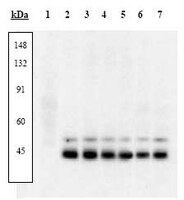506119 Sigma-AldrichPhosphoDetect™ Anti-p38 MAP Kinase (pThr¹⁸⁰, pTyr¹⁸²) Rabbit pAb
This PhosphoDetect™ Anti-p38 MAP Kinase Rabbit pAb is validated for use in WB, ICC for the detection of p38 MAP Kinase .
More>> This PhosphoDetect™ Anti-p38 MAP Kinase Rabbit pAb is validated for use in WB, ICC for the detection of p38 MAP Kinase . Less<<Recommended Products
Overview
| Replacement Information |
|---|
Key Specifications Table
| Species Reactivity | Host | Antibody Type |
|---|---|---|
| Ca, H, M, R | Rb | Polyclonal Antibody |
Products
| Catalog Number | Packaging | Qty/Pack | |
|---|---|---|---|
| 506119-10T | Plastic ampoule | 10 t |
| Product Information | |
|---|---|
| Form | Liquid |
| Formulation | In Dulbecco's PBS (without Mg2+ and Ca2+), 1 mg/ml BSA, 50% glycerol, pH 7.3. |
| Positive control | UV irradiated HEK293 cells or sorbitol-treated PC12 cells |
| Preservative | ≤0.1% sodium azide |
| Quality Level | MQ100 |
| Physicochemical Information |
|---|
| Dimensions |
|---|
| Materials Information |
|---|
| Toxicological Information |
|---|
| Safety Information according to GHS |
|---|
| Safety Information |
|---|
| Product Usage Statements |
|---|
| Packaging Information |
|---|
| Transport Information |
|---|
| Supplemental Information |
|---|
| Specifications |
|---|
| Global Trade Item Number | |
|---|---|
| Catalog Number | GTIN |
| 506119-10T | 04055977199451 |
Documentation
PhosphoDetect™ Anti-p38 MAP Kinase (pThr¹⁸⁰, pTyr¹⁸²) Rabbit pAb SDS
| Title |
|---|
PhosphoDetect™ Anti-p38 MAP Kinase (pThr¹⁸⁰, pTyr¹⁸²) Rabbit pAb Certificates of Analysis
| Title | Lot Number |
|---|---|
| 506119 |
References
| Reference overview |
|---|
| Marinissen, M.J., et al. 2001. Genes Dev. 15, 535. Nakagami, H., et al. 2001. Diabetes 50, 1472. Wilsbacher, J.L., et al. 1999. J. Biol. Chem. 274, 16988. Raingeaud, J., et al. 1995. J. Biol. Chem. 270, 7420. Zervos, A.S., et al. 1995. Proc. Natl. Acad. Sci. USA 92, 10531. Han, J., et al. 1994. Science 265, 808. Lee, J.C., et al. 1994. Nature 372, 739. Rouse, J., et al. 1994. Cell 78, 1027. |
Brochure
| Title |
|---|
| MAPK Pathway Poster ( 750 KB ) |








